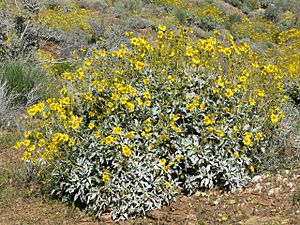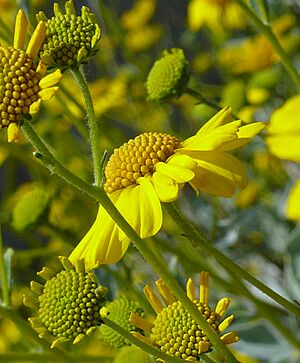Brittlebush facts for kids
Quick facts for kids Encelia farinosa |
|
|---|---|
 |
|
| near Palm Springs, California | |
| Scientific classification | |
| Kingdom: | |
| (unranked): | |
| (unranked): | |
| (unranked): | |
| Order: | |
| Family: | |
| Genus: |
Encelia
|
| Species: |
E. farinosa
|
| Binomial name | |
| Encelia farinosa Torr. & A.Gray
|
|
Encelia farinosa, often called brittlebush or brittlebrush, is a common desert shrub. You can find it in dry areas of northern Mexico and the southwestern United States. This includes places like California, Arizona, Utah, and Nevada.
It's called 'brittlebush' because its stems break easily. In Spanish, it's sometimes called incienso. This is because early Spanish explorers used its dried sap as a sweet-smelling incense.
Contents
Where Brittlebush Lives
Brittlebush grows in many dry places. You can find it on rocky hillsides or in sandy riverbeds. It loves lots of sunshine and needs soil that drains water well. It also doesn't like too much winter frost.
This plant is often grown in gardens, especially in dry areas. People use it to stop soil from washing away. It can also cover large areas of ground. Sometimes, it spreads to new places because it's used in special planting mixes for roadsides.
What Brittlebush Looks Like
Brittlebush plants usually grow about 30 to 150 centimeters (about 1 to 5 feet) tall. Their leaves are 3 to 8 centimeters long. They are often oval-shaped and look silvery because they are covered in tiny hairs.
The plant has bright orange-yellow flowers that look like daisies. These flowers are about 3 to 3.5 centimeters wide. They grow in loose groups above the leafy stems. When the weather gets very dry, the plant drops all its leaves. It then uses water stored in its thick stems to survive.
How People Use Brittlebush
Brittlebush has been used by native peoples and early settlers for a long time.
Natural Glue
The plant produces a sticky substance called resin. This resin can be collected from the bottom of the plant. When heated, it turns into a yellowish-brown glue. Native American groups like the O'odham and Seri used this glue. They would use it to attach arrowheads to arrows or tips to harpoons.
Sealing and Waterproofing
A different kind of resin comes from the upper stems. This resin is more like a clear, yellow gum. The Seri people used it to seal their pottery. This helped to make the pots hold water better. People also used it to make other containers waterproof.
Sweet-Smelling Incense
Early Spanish friars learned about the resin from native peoples. They found that when the resin was burned, it smelled very nice. It was used as a fragrant incense, similar to frankincense.
Chewing Gum
Children from the Tohono Oʼodham tribe in the Sells area sometimes used the resin from the upper stems. They would chew it like gum.
Toothbrush
In the past, cowboys sometimes used a brittlebush stem as a simple toothbrush.
Traditional Medicine
Native American tribes used brittlebush for different health needs.
- The Seri people used it for toothaches. They would remove the bark, heat a branch in ashes, and then place it in the mouth to help a loose tooth.
- The Cahuilla tribe also used brittlebush for toothaches. They would heat the gum and put it on the chest to help with chest pain.
Varnish
The resin from brittlebush could also be melted down. It was then used as a type of varnish to coat surfaces.
Images for kids
-
E. farinosa in California's Colorado Desert
See also
 In Spanish: Encelia farinosa para niños
In Spanish: Encelia farinosa para niños



